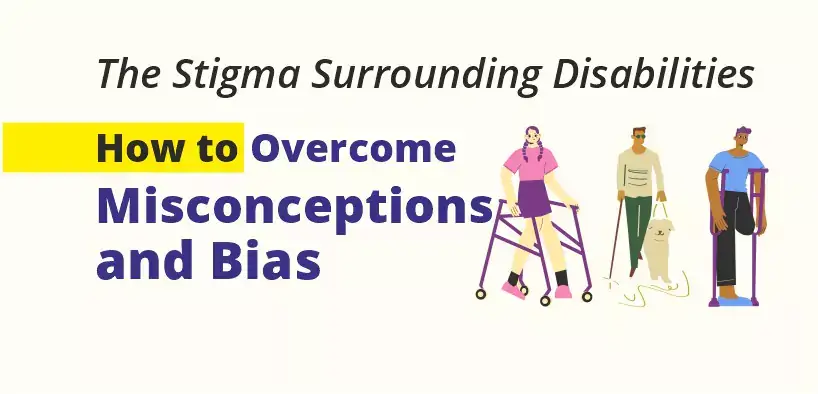What is a Disability? What is Stigma? Understanding the Stigma Surrounding Disabilities
In today’s society, individuals with disabilities often face not only the challenges that come with their condition but also the burden of stigma and bias. A disability is a physical, sensory, intellectual, or mental impairment that affects a person’s ability to perform daily activities. Stigma, on the other hand, refers to the negative attitudes, beliefs, and stereotypes that society holds about people with specific characteristics such as their nationality, ethnicity, faith, religion, gender identity, sexuality, mental health, and intellectual and physical disability.
Some of the existing or possible societal stigmas around disabilities are:
-
- Pity and Infantilization: People with disabilities may be subject to pity or treated as helpless individuals who need constant assistance. This can undermine their autonomy and reinforce stereotypes of dependence.
- Stereotyping and Misconceptions: Individuals with disabilities are often subject to stereotyping, such as assumptions that they are less capable, less intelligent, or unable to lead fulfilling lives. These misconceptions disregard the unique abilities and potential of individuals with disabilities.
- Exclusion and Social Isolation: Individuals with disabilities may experience exclusion and social isolation, facing difficulties in accessing public spaces, educational institutions, employment opportunities, and social gatherings due to physical or attitudinal barriers.
- Bullying, Harassment & Sexual Violence: People with disabilities can be targets of bullying, harassment and sexual violence, both in person and online. This can lead to physical injury, emotional distress, low self-esteem, and further social isolation. According to a 2004 British study, people with disabilities are more likely to be raped or violently abused, and less likely to receive police intervention or legal protection. The Global Campaign for Education (2011) reports that violence against children with disabilities occurs at 1.7 times the rate of violence against their peers without disabilities.
- Employment Discrimination: Individuals with disabilities often face discrimination in the workplace due to stereotypes and misconceptions, including lower employment rates, limited career advancement opportunities, and unequal pay. According to the International Labour Organization (ILO), approximately 386 million working-age people worldwide suffer from some sort of disability. In some countries, the unemployment rate among people with disabilities reaches 80 percent. People with disabilities are often assumed to be unable to work by employers (ILO).
- Inaccessible Environments: Physical environments that lack accessibility features, such as ramps, elevators, and accessible restrooms, can create barriers for individuals with mobility impairments. Similarly, digital barriers, like websites or technology without proper accessibility features, can exclude individuals with visual or hearing impairments.
- Microaggressions and Insensitive Language: Individuals with disabilities may encounter microaggressions, which are subtle, often unintentional, discriminatory remarks or actions. Additionally, the use of derogatory language or slurs can perpetuate stigma and contribute to the marginalization of people with disabilities.
- Assumptions about Mental Health: Invisible disabilities, including mental health conditions, are frequently misunderstood and stigmatized. Individuals may face dismissive attitudes, skepticism about their experiences, or pressure to conceal their conditions due to the fear of judgment or discrimination.
What can we do to stop the Disability Stigmas?
Stopping disability stigma requires collective efforts and a commitment to fostering inclusive and accepting societies. Here are some ways we can help stop or end these stigmas:
-
- Education and Awareness: Promote education and awareness about disabilities to challenge misconceptions and stereotypes. Encourage disability inclusion training in schools, workplaces, and communities to foster understanding and empathy.
- Language and Communication: Use respectful and person-first language when referring to individuals with disabilities. Avoid derogatory terms or offensive language that perpetuates stereotypes. Encourage open and inclusive communication that values diverse experiences and perspectives.
- Representation and Media: Advocate for the accurate and positive representation of individuals with disabilities in the media, including films, TV shows, and advertising. Promote stories that showcase their achievements, challenges, and contributions, helping to break down stereotypes and promote inclusion.
- Accessibility and Universal Design: Support the creation of accessible environments that accommodate the needs of individuals with disabilities. This includes providing physical accessibility features, such as ramps, elevators, and accessible restrooms, as well as ensuring digital accessibility for websites, applications, and technology.
- Employment and Economic Inclusion: Encourage inclusive hiring practices and provide equal employment opportunities for individuals with disabilities. Foster workplace environments that value diversity and provide reasonable accommodations to enable individuals with disabilities to thrive in their careers. A report by the International Labor Organization (ILO) highlights that creating accessible work environments and providing reasonable accommodations can significantly improve employment outcomes for individuals with disabilities by reducing stigma and promoting inclusivity.
- Advocacy and Empowerment: Support disability advocacy organizations, NGOs, and individuals who are actively working to challenge stigma and fight for the rights of people with disabilities. Amplify their voices and promote their initiatives to bring about systemic change. A study published in the Journal of Disability Policy Studies found that self-advocacy training programs for individuals with disabilities have been effective in empowering them to challenge stigma and discrimination, leading to increased self-confidence and participation in society.
- Personal Reflection and Empathy: Engage in self-reflection to identify and challenge personal biases or preconceptions about disabilities. Cultivate empathy by listening to and learning from the experiences of individuals with disabilities. Treat everyone with dignity, respect, and equality.
Remember, ending disability stigmas is an ongoing process that requires long-term commitment and continuous efforts. By taking these actions, we can contribute to creating a more inclusive and accepting society for everyone, regardless of their abilities.








